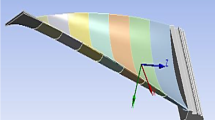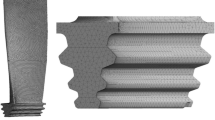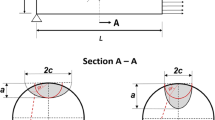Abstract
The blades of gas turbines are usually faced with high temperature and pressure changes, which in most cases cause the appearance and growth of micro-cracks in the blade and lead to failure. Since the loading applied to the turbine is in the mixed mode (I/II/III), therefore, the prediction of crack growth in these materials also requires an investigation in the mixed mode. In the present research, the numerical approach is addressed for investigation of the mixed mode (I/II/III) fracture of gas turbine blade considering semi-elliptical crack. In this context, the effects of semi-elliptical crack, size effect of blade, critical location and composite coating material are investigated for the rotational gas turbine blade. Eventually, stress intensity factors are obtained and compared for various crack location, aspect ratio, rotational speed and materials.
























Similar content being viewed by others
References
Ayhan AO (2000) Finite element analysis of nonlinear deformation mechanisms in semiconductor packages. Lehigh University, Lehigh
Ayhan AO (2007) Mixed mode stress intensity factors for deflected and inclined corner cracks in finite-thickness plates. Int J Fatigue 29(2):305–317
Ayhan AO (2011) Three-dimensional fracture analysis using tetrahedral enriched elements and fully unstructured mesh. Int J Solids Struct 48(3–4):492–505
Ayhan AO, Nied HF (2002) Stress intensity factors for three-dimensional surface cracks using enriched finite elements. Int J Numer Meth Eng 54(6):899–921
Baker AA (1984) Repair of cracked or defective metallic aircraft components with advanced fibre composites—an overview of Australian work. Compos Struct 2(2):153–181
Baker A (1999) Bonded composite repair of fatigue-cracked primary aircraft structure. Compos Struct 47(1–4):431–443
Baker AA, Callinan RJ, Davis MJ, Jones R, Williams JG (1984) Repair of Mirage III aircraft using the BFRP crack-patching technique. Theoret Appl Fract Mech 2(1):1–5
Baker AA (1988) Crack patching: experimental studies, practical applications. In: Bonded repair of aircraft structures (pp 107–173). Springer, Dordrecht.
Barsoum RS (1976) On the use of isoparametric finite elements in linear fracture mechanics. Int J Numer Meth Eng 10(1):25–37
Belytschko T, Black T (1999) Elastic crack growth in finite elements with minimal remeshing. Int J Numer Meth Eng 45(5):601–620
Benzley SE (1974) Representation of singularities with isoparametric finite elements. Int J Numer Meth Eng 8(3):537–545
Branco R, Antunes FV (2008) Finite element modelling and analysis of crack shape evolution in mode-I fatigue middle cracked tension specimens. Eng Fract Mech 75(10):3020–3037
Branco R, Rodrigues DM, Antunes FV (2008) Influence of through-thickness crack shape on plasticity induced crack closure. Fatigue Fract Eng Mater Struct 31(2):209–220
Branco R, Antunes FV, Ricardo LC, Costa JD (2012) Extent of surface regions near corner points of notched cracked bodies subjected to mode-I loading. Finite Elem Anal Des 50:147–160
Bremberg D, Dhondt G (2008) Automatic crack-insertion for arbitrary crack growth. Eng Fract Mech 75(3–4):404–416
Çetin M, Yaman K (2020) Location, size and orientation effect of semi-elliptical surface crack on the fracture of a type-3 composite pressure vessel using J-integral method. Defence Sci J 70(1):1
Chen AJ, Zeng WJ (2006) Weight function for stress intensity factors in rotating thick-walled cylinder. Appl Math Mech 27(1):29–35
Fawaz SA (1998) Application of the virtual crack closure technique to calculate stress intensity factors for through cracks with an elliptical crack front. Eng Fract Mech 59(3):327–342
Fett T (2002) Stress intensity factors and T-stress for single and double-edge-cracked circular disks under mixed boundary conditions. Eng Fract Mech 69(1):69–83
Fett T, Bahr HA (1999) Mode I stress intensity factors and weight functions for short plates under different boundary conditions. Eng Fract Mech 62(6):593–606
Funazaki K, Tarukawa Y, Kudo T, Matsuno S, Imai R and Yamawaki S (2001) Heat transfer characteristics of an integrated cooling configuration for ultra-high temperature turbine blades: experimental and numerical investigations. In: Turbo expo: power for land, sea, and air (Vol 78521, p V003T01A031). Am Soc Mech Eng
Garcia-Manrique J, Camas D, Gonzalez-Herrera A (2017) Study of the stress intensity factor analysis through thickness: methodological aspects. Fatigue Fract Eng Mater Struct 40(8):1295–1308
Han Q, Wang Y, Yin Y, Wang D (2015) Determination of stress intensity factor for mode I fatigue crack based on finite element analysis. Eng Fract Mech 138:118–126
Jones IS, Rothwell G (2001) Reference stress intensity factors with application to weight functions for internal circumferential cracks in cylinders. Eng Fract Mech 68(4):435–454
Kai-** M, Chun-tu L (2004) Semi-weight function method on computation of stress intensity factors in dissimilar materials. Appl Math Mech 25(11):1241–1248
Knott JF (1973) Fundamentals of fracture mechanics. Gruppo Italiano Frattura.
Koshima T, Okada H (2015) Three-dimensional J-integral evaluation for finite strain elastic–plastic solid using the quadratic tetrahedral finite element and automatic meshing methodology. Eng Fract Mech 135:34–63
Kotousov A, Berto F, Lazzarin P, Pegorin F (2012) Three dimensional finite element mixed fracture mode under anti-plane loading of a crack. Theoret Appl Fract Mech 62:26–33
Kumar A, Keane AJ, Nair PB and Shahpar S (2006) Robust design of compressor blades against manufacturing variations. In: international design engineering technical conferences and computers and information in engineering conference (Vol 4255, pp 1105–1118)
Li YG (2010) Gas turbine performance and health status estimation using adaptive gas path analysis. J Eng Gas Turbines Power 132(4):041701. https://doi.org/10.1115/1.3159378
Liu H, Yang X, Li S, Shi D (2020) A numerical approach to simulate 3D crack propagation in turbine blades. Int J Mech Sci 171:105408
Maschke HG, Kuna M (1985) A review of boundary and finite element methods in fracture mechanics. Theoret Appl Fract Mech 4(3):181–189
Mattheck C, Morawietz P, Munz D (1983a) Stress intensity factor at the surface and at the deepest point of a semi-elliptical surface crack in plates under stress gradients. Int J Fract 23(3):201–212
Mattheck C, Munz D, Stamm H (1983b) Stress intensity factor for semi-elliptical surface cracks loaded by stress gradients. Eng Fract Mech 18(3):633–641
Mavrothanasis FI, Pavlou DG (2007) Mode-I stress intensity factor derivation by a suitable green’s function. Eng Anal Boundary Elem 31(2):184–190
Montoya J (1966) Coupled bending and torsional vibrations in a twisted rotating blade. Brown Boveri Rev 53(3):216–230
Mouna A, Boukortt H, Meliani MH, Muthanna BG, Suleiman RK, Sorour AA, Pluvinage G, Azari Z (2020) Corrosion effect, constraint and path orientation estimated in cracked gas turbine blade. Eng Fail Anal 110:104345
Nikishkov GP, Atluri SN (1987) Calculation of fracture mechanics parameters for an arbitrary three-dimensional crack, by the ‘equivalent domain integral’method. Int J Numer Meth Eng 24(9):1801–1821
Noda NA, Xu C (2008) Controlling parameter of the stress intensity factors for a planar interfacial crack in three-dimensional bimaterials. Int J Solids Struct 45(3–4):1017–1031
O’Hara P, Duarte CA, Eason T (2016) A two-scale generalized finite element method for interaction and coalescence of multiple crack surfaces. Eng Fract Mech 163:274–302
Okada H, Kawai H, Araki K (2008) A virtual crack closure-integral method (VCCM) to compute the energy release rates and stress intensity factors based on quadratic tetrahedral finite elements. Eng Fract Mech 75(15):4466–4485
Okada H, Kawai H, Tokuda T, Fukui Y (2013) Fully automated mixed mode crack propagation analyses based on tetrahedral finite element and VCCM (virtual crack closure-integral method). Int J Fatigue 50:33–39
Okada H, Koya H, Kawai H, Li Y, Osakabe K (2016) Computations of stress intensity factors for semi-elliptical cracks with high aspect ratios by using the tetrahedral finite element (fully automated parametric study). Eng Fract Mech 158:144–166
Rajaram H, Socrate S, Parks DM (2000) Application of domain integral methods using tetrahedral elements to the determination of stress intensity factors. Eng Fract Mech 66(5):455–482
Raju IS (1977) Improved stress-intensity factors for semi-elliptical surface cracks in finite-thickness plates. NASA.
Rose LR (1981) An application of the inclusion analogy for bonded reinforcements. Int J Solids Struct 17(8):827–838
Sanati H, Amini A, Reshadi F, Soltani N, Faraji G, Zalnezhad E (2015) The stress intensity factors (SIFs) of cracked half-plane specimen in contact with semi-circular object. Theoret Appl Fract Mech 75:104–112
Sarraf C, Nouri H, Ravelet F, Bakir F (2011) Experimental study of blade thickness effects on the overall and local performances of a controlled vortex designed axial-flow fan. Exp Thermal Fluid Sci 35(4):684–693
Seifi R (2015) Stress intensity factors for internal surface cracks in autofrettaged functionally graded thick cylinders using weight function method. Theoret Appl Fract Mech 75:113–123
Shivakumar KN, Tan PW and Newman Jr JC (1988) A virtual crack-closure technique for calculating stress intensity factors for cracked three dimensional bodies. Int J Fract 36:43–50. https://doi.org/10.1007/BF00035103
Sukumar N, Dolbow JE, Moës N (2015) Extended finite element method in computational fracture mechanics: a retrospective examination. Int J Fract 196(1):189–206
Tao CH, Zhong PD, Li RZ (2000) Failure analysis and prevention for rotor in aero-engine. National Defence Industry Press, China, pp 102–163
Tsang DK, Oyadiji SO, Leung AY (2007) Two-dimensional fractal-like finite element method for thermoelastic crack analysis. Int J Solids Struct 44(24):7862–7876
Tweed J, Rooke DP (1973) The stress intensity factor of an edge crack in a finite elastic disc. Int J Eng Sci 11(1):65–73
Tweed J, Das SC, Rooke DP (1972) The stress intensity factors of a radial crack in a finite elastic disc. Int J Eng Sci 10(3):323–335
Valentin G, Arrat D (1991) Stress intensity factors of semi-elliptical cracks in single-or double-layered spherical shells. Int J Press Vessels Pip 48(1):9–20
Vigdergauz S (1996) An effective method for computing the elastic field in a finite cracked disk. Eng Fract Mech 53(4):545–556
Wang YH, Tham LG, Lee PK, Tsui Y (2003) A boundary collocation method for cracked plates. Comput Struct 81(28–29):2621–2630
Wee JW, Chudnovsky A, Choi BH (2020) Discontinuous slow crack growth modeling of semi-elliptical surface crack in high density polyethylene using crack layer theory. Int J Solids Struct 185:65–77
Yasmina A, Bacha N, Semmar D (2008) Probabilistic model for pitting corrosion and fatigue life estimation of turbine blades. Integritet I Vek Konstrukcija 8(1):3–12
Ying Y, Cao Y, Li S, Li J, Guo J (2016) Study on gas turbine engine fault diagnostic approach with a hybrid of gray relation theory and gas-path analysis. Adv Mech Eng 8(1):1687814015627769
Zhou D, Wei T, Huang D, Li Y, Zhang H (2020) A gas path fault diagnostic model of gas turbines based on changes of blade profiles. Eng Fail Anal 109:104377
Author information
Authors and Affiliations
Corresponding author
Rights and permissions
Springer Nature or its licensor (e.g. a society or other partner) holds exclusive rights to this article under a publishing agreement with the author(s) or other rightsholder(s); author self-archiving of the accepted manuscript version of this article is solely governed by the terms of such publishing agreement and applicable law.
About this article
Cite this article
Ghoreishi, S.M.N., Mehri Khansari, N. Mode (I, II, III) Stress Intensity Factors of Composite-Coated Gas Turbine Blade Using Semi-Elliptical Crack. Iran J Sci Technol Trans Mech Eng 47, 1841–1857 (2023). https://doi.org/10.1007/s40997-023-00592-7
Received:
Accepted:
Published:
Issue Date:
DOI: https://doi.org/10.1007/s40997-023-00592-7




